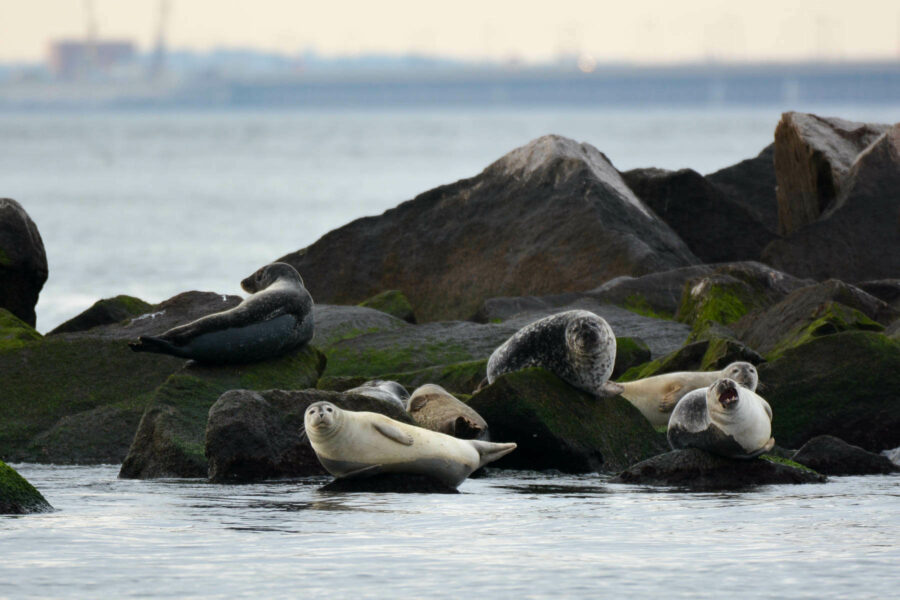Harbor seals are becoming a regular highlight of winter in the Chesapeake Bay

When you picture a harbor seal, you might imagine it in the Arctic surrounded by ice, but the mammal is actually an annual visitor to the Chesapeake Bay. Juvenile seals will travel south from New England every winter to enjoy the warmer waters and plentiful fish population of the Bay region. They stay in the area from December through May and return to New England when water temperatures rise—but if you’re lucky, you may spot one while it’s here.
Harbor seals are the most common type of seal found in the Bay, although grey seals, harp seals and hooded seals are occasionally spotted. Seals are often seen by the Chesapeake Bay Bridge Tunnel and along Virginia’s Eastern Shore, although they’ve been occasionally spotted in the Maryland portion of the Bay as far north as Baltimore. In the past few decades, the number of visiting seals has increased dramatically. Fishermen and scientists have noticed a change from seeing just a few in a season to dozens every winter. The increased number of seals even led the Virginia Aquarium & Marine Science Center to start offering seal spotting boat tours during the late winter months.
The increase in sightings is attributed to the overall harbor seal population growth. Throughout the 1940’s and 1950’s, the harbor seal population dropped dramatically due to government approved hunting. Hunting was approved because people believed the seals were competing with local fisheries but was outlawed in 1960. In addition, the Marine Mammal Protection Act was put in place in 1972, which made it illegal to harm or “harass” seals. These two acts have helped harbor seal populations climb to a stable number. The exact number of seals in the Bay region will fluctuate with the severity of the winters—in years with mild winters, seals will stay in northern regions and in severe winters, more seals will migrate south.
Harbor seal migration and behavior
Harbor seals are normally seen when they pop their heads above water or when they rest on rocks and beaches, an activity known as “hauling out.” Harbor seals haul out to rest, warm up in the sun and to congregate for mating. Haul out sites are picked based on food availability and protection from predators. However, as global temperatures rise and sea ice melts, the marine food web is significantly impacted. The lack of food and change in temperature will impact when and where harbor seals migrate, and with increasingly warming air and water temperatures, these new seasonal visitors might be forced out of the Bay.
One of the biggest threats to harbor seals has been interference from well-intentioned people who find infant seals who they think have been abandoned. Mother seals will often leave pups alone while they hunt, and under the false impression that the pup is lost, concerned citizens will try to rescue them. Once a mother seal and pup have been separated, it is very difficult to reconnect the pair, and raising seal pups in captivity is typically unsuccessful.
What to do if you spot a harbor seal
In rare instances when a seal pup has been abandoned, the cause is often that people have ventured too close to the pup and scared the mother away. If there is concern that a pup is abandoned, keep your distance and call your local marine animal center.
People can also contact their local marine center to report sightings of healthy animals, which helps scientists track populations. Bear in mind that resting on beaches is a normal part of seal activity and does not signal that a seal is injured. Seals can be on land to regulate their body temperature, rest and escape predators. If approached by a human, the seal might be spooked and jump back into the water when it needs to be on land. It is always better to err on the side of caution and keep a 150-foot distance from the careful critter.
Seeing a seal in the Bay region is an exciting event. If you see a seal remember to:
- Keep your distance.
- Stay quiet and out of sight.
- Take a picture to send to your local marine animal center.
- Prevent people from crowding the beach to see the seal by waiting to post on social media or post without a location tag.
- Enjoy the special occasion and celebrate the return of the harbor seal.
To learn more about the harbor seal and other mammals that visit the Chesapeake Bay watershed take a look at our Field Guide.

Comments
I recall when out on the Oregon coast that we were told that a lone seal pup may not be abandoned but stashed while the mother is hunting.
Thank you!
Your comment has been received. Before it can be published, the comment will be reviewed by our team to ensure it adheres with our rules of engagement.
Back to recent stories